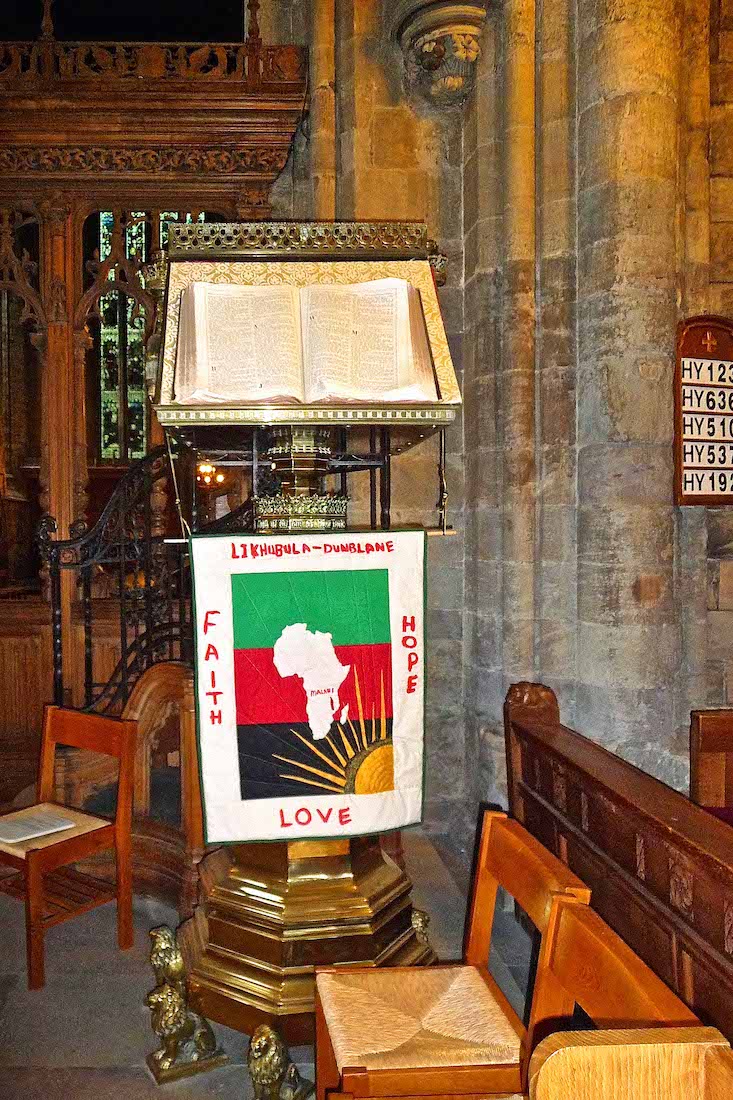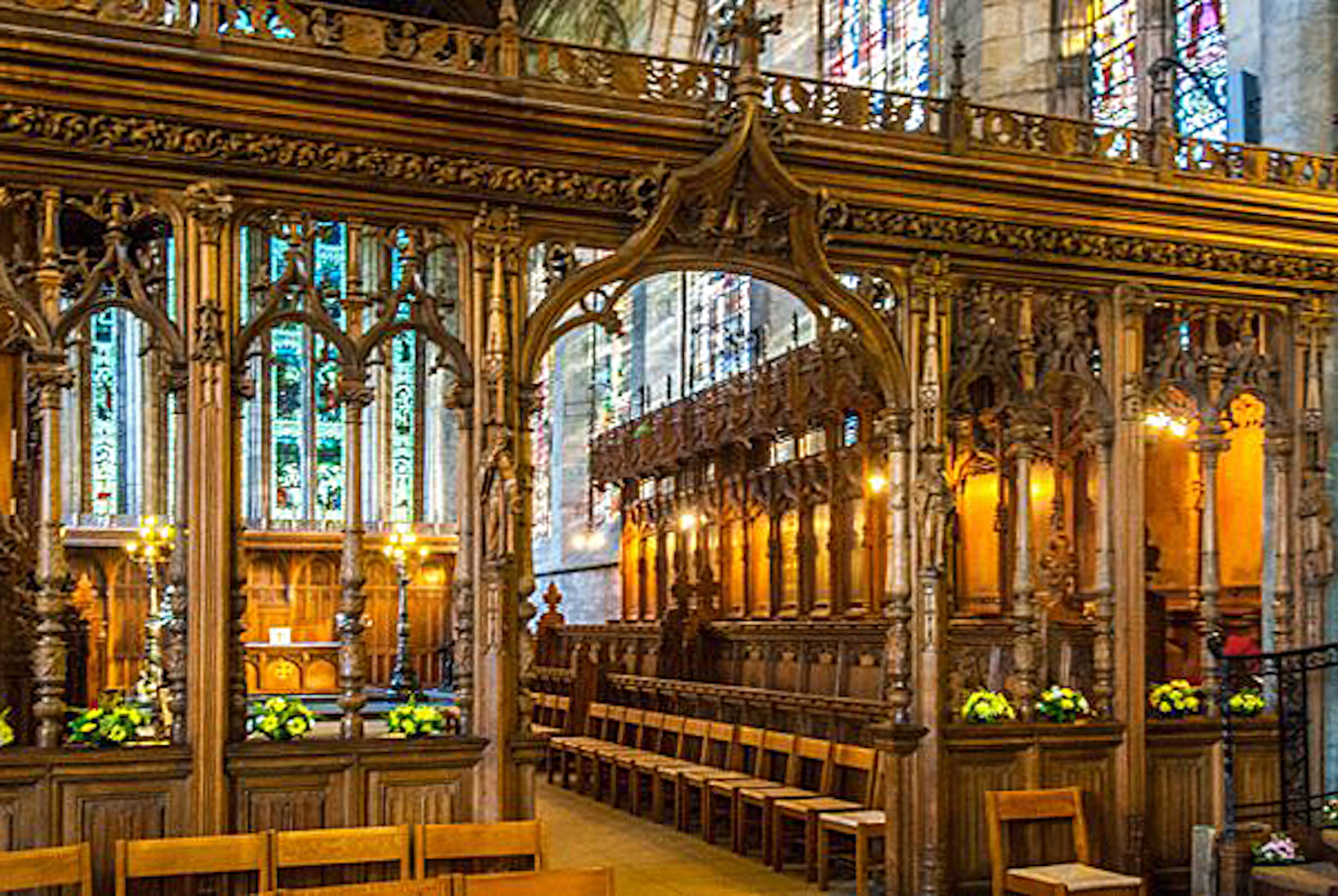

Standing by the West door looking down the aisle, we turn to the right to see the baptismal font. The baptismal font was designed by Sir Rowand Anderson, and gifted by Mrs Wallace of Glassingall who funded the restoration of the Cathedral in 1889. There is a stained glass window above the font and a brass plate. Also on the right there appears to be a raised fenced balcony? INDEX
22. STRACHAN WINDOW GA

The Baptismal Window near the font is by Douglas Strachan of Edinburgh, dedicated in 1926 and the gift of Mr and Mrs J D Nimmo of Dunblane, and shows the Baptism of Christ by John the Baptist in the waters of Jordan.
23. WAR MEMORIAL IWM
The large brass plaque is in memory of John Duncan Nimmo. It shows at left a Celtic cross and the RAF insignia. The text reads: TO THE GLORY OF GOD AND IN MEMORY OF JOHN DUNCAN NIMMO/ EAST INDIA MERCHANT WHO WITH HIS WIFE GAVE THE/ WINDOW ABOVE BORN AT ABERCORN WEST LOTHIAN/ HE LIVED IN DUNBLANE FROM 1906 TO 1919 AND DIED AT/ NAIROBI KENYA COLONY 6TH APRIL 1925 AGED 64/ ALSO IN MEMORY OF HIS THIRD SON ROBERT LOUIS/ OF THE LONDON STOCK EXCHANGE FLYING OFFICER/ COUNTY OF MIDDLESEX SQUADRON AUXILIARY AIR FORCE/ WHO WAS BORN IN DUNBLANE AND WAS KILLED FLYING/ AT HENDON 4TH AUGUST 1935 AGED 28/ MAY THE LIGHT ETERNAL SHINE ON THEM AND ON ALL CHILDREN CHRISTENED IN THIS PLACE. [Photo Credit: Imperial War Museum © WMR-69235]
24. TO CLEMENT CHAPEL SC SC
This photo shows a special memorial: we shall return to this. But looking towards the more distant font we see that there are stairs behind, leading to an open door. Above the stairs is an old Cradle Roll. The Cradle Roll was commissioned by the Church of Scotland for reproduction, and the artist, Helen A. Lamb of Dunblane, presented the original to the congregation of Dunblane Cathedral, of which she was a member.
25. CLEMENT CHAPEL JS GA
The door leads through to the Clement Chapel, named after Bishop Clement, which was restored in 1964 under the supervision of architect Edith Burnet Hughes. This Chapel is small and bounded by the Cathedral walls. The carved figure of Christ in Majesty is by Maxwell Allan. There is a small display of the works of artist Helen Lamb.
26. CHAPEL WINDOW AND DISPLAY GA SC
At right is an example of the work of Helen Lamb. • In the passageway is a small stained glass window depicting Clement, designed and gifted by Gordon Webster in 1964. Bishop Clement, the builder of the Cathedral, is depicted clad in a blue chasuble and stole and wearing a mitre, against a red background and in the lower right hand corner the etoile of six rays of his episcopal seal. This slit window can of course be viewed from the outside. It looks like this.
27. SOUTH AISLE DC
We leave the Clement Chapel and turn to the South aisle. At left is the memorial we mentioned earlier. Further down we can see the intrusion of the tower into the aisle, and we can just make out a set of steps leading up about three feet to a small landing. From here, the bell ringers can gain access to the tower.
28. A WINDOW AND THE MASSACRE MEMORIAL GA GA
Above the Southwest doorway in the South Aisle is a two-lighted window in memory of Colonel J Boyd Wilson. The figures represent St George and Hope, and the artist was Louis Davis, London. A little further along the aisle stands a stone commemorating the events of 13 March 1996 when many people, mostly young children, were killed in a tragic mass shooting at Dunblane Primary School. The memorial, by sculptor Richard Kindersley of London, carries literary extracts on all four sides, relating to children.
29. DEPARTURE AND ARRIVAL GA GA
Between the tower and the south-west doorway are the Barty windows, erected in 1917 by the family of Dr and Mrs J W Barty in their memory. The artist was Louis Davis of London. The subject of these two windows is the ‘Nunc Dimittis’, or Song of Simeon (St Luke 2: 29-32). They carry the general themes of Departure (at left) and Arrival (at right).
30. TWO MORE WINDOWS JG GA
Continuing our walk down the South aisle, we pass the tower with its stairway access, to find two more windows. One is the small window in the East end wall of the aisle (at left) which was erected in memory of Rev Dr Henry M Hamilton who died in 1903. The figures are John the Baptist and the Good Shepherd. The other is a large window (at right) in memory of Mr and Mrs David Wallace of Glassingall, placed here by their daughters. The figures represented are: St Peter, St Paul, St John, St Matthew, St Mark, St Luke, St Jude, St James – the apostles whose writings are enshrined in the New Testament.
31. GLASS SCREEN GA
This East end of the South aisle is separated from the nave by a modern but discreet glass screen, shielding the seated congregation from the cold Scottish weather. The screen is a memorial to Helen A Lamb. The three etchings can be seen here in more detail.
32. PULPIT, SCREEN, LECTERN DCl
We come to the front of the central nave. Before us are the lectern, the choir screen and the pulpit. The lectern is impressive with a Bible support front and back, and a special set of steps to access it.
[Photo Credit: Dave Cleghorn : https://flickr.com/photos/8229142@N07/48673875086 ]
33. LECTERN GA
This lectern is supported by a troop of lions, rather than the usual three. It is from here that the scripture is read Sunday by Sunday. • The banner refers to the Dunblane Likhubula Link which joins the community of Dunblane in Scotland with the community of Likhubula, a rural community in the Mulanje district of Malawi. Dunblane Cathedral directly supports projects focusing on clean water supplies, agriculture, and education, as well as maintaining frienship links between the two communities.
34. CHOIR SCREEN BE
A medieval Cathedral’s primary function was to be the setting for an unceasing round of daily services said or sung by a team of clergy, called the Chapter. The laity did not participate in these services which took place in the Choir. Although the building itself has a large arch connecting the Choir with the Nave, a screen, like the one shown here, cut off the laity and permitted only the most limited view of the high altar.
[Photo Credit: Britain Express : https://www.britainexpress.com/attractions.htm?attraction=1055 ]
35. SCREEN FIGURES JG JG JG
The choir screen features these three figures – from left: St Paul, King David (making a musical contribution), and John the Baptist. This screen dates from the 1880s. Part of the original screen still exists and is on display in the Dunblane Museum.
36. PULPIT W:JS
In turning to the pulpit, we notice the one stained glass window in this North wall of the nave. On the canopy of the pulpit are carved the words: ‘Jesus Christ, the same yesterday, today and for ever’. [Photo Credit: CCL Wikimedia: John Salmon]
37. PULPIT DETAIL GA JG
The pulpit, designed as part of the restoration by Anderson, reflects the history of the Cathedral through its seven carved figures. These are: Principal Carstares: (1649-1715), the guide of the Revolution Settlement which restored Presbyterianism; • Gilbert, 3rd Earl of Strathearn (died 1223), who gave a third of his lands for the upkeep of the bishopric; • David I (1124-1153), who was King when the bishopric was re-founded; • John Knox (1514-1572) who was the main inspirer of the Reformation in Scotland; • St Blane from whom Dunblane gets its name; • Clement, Bishop of Dunblane (1233-1258, who built the Cathedral. • Robert Leighton, Bishop of Dunblane 1662-1671, the ‘saintly’ bishop who, in desperately difficult times, attempted to lead the church beyond the bitterness of the conflict between episcopacy and presbyterianism. Between the figures are various inlaid symbols of our Lord’s passion and crucifixion. Notice the rather grand memorial on the wall behind the pulpit.
38. PULPIT FIGURES SC SC
Close up views of King David I and John Knox.
39. PULPIT STAIRS JG
The sweeping stairs up to the pulpit are guarded by ...































